2022 Toyota 86 Maintenance | Tips and Services User manual
Taking care of the 2022 Toyota 86 is important to make sure it runs well and lasts a long time. People who own Toyota 86s can keep them in great shape for years to come by focusing on preventative care and regular maintenance. Keeping up with a full maintenance plan is important for keeping the 86 running well. This includes everything from changing the oil and filters to rotating the tires and checking the brakes. Knowing what this sports car needs and following the manufacturer’s advice can help you avoid expensive fixes in the future. Owners of the Toyota 86 can enjoy a smooth and reliable driving experience as long as they keep up with the vehicle’s repair needs. Looking into services and tips that are specifically made for the Toyota 86 can help you figure out how to take the best care of this high-performance car. Whether you do the maintenance yourself or have a professional do it, making maintenance a priority for your 2022 Toyota 86 is important for getting the most out of it on the road.
2023 Toyota GR86 Specs, Price, Features and Mileage (Brochure)
Do-it-yourself service precautions
Toyota 86 maintenance guide
If you perform maintenance by yourself, be sure to follow the correct procedure as given in these sections
Maintenance
| Items | Parts and tools |
|
Battery condition |
• Warm water
• Baking soda • Grease • Conventional wrench (for terminal clamp bolts) |
|
Brake fluid and Clutch fluid level |
• SAE J1703 or FMVSS No.116 DOT 3 brake fluid
• Rag or paper towel • Funnel (used only for adding brake fluid and clutch fluid) |
| Items | Parts and tools |
|
Engine coolant level |
• “TOYOTA Genu- ine 50/50
Pre-mixed Super Long Life Coolant BLUE” or a similar high-quality ethylene gly- col-based non-silicate, non-amine, non-nitrite and non-borate cool- ant with long-life hybrid organic acid technology. • For the U.S.A.: “TOYOTA Genu- ine 50/50 Pre-mixed Super Long Life Coolant BLUE” is pre-mixed with 50% coolant and 50% deionized water. • For Canada: “TOYOTA Genu- ine 50/50 Pre-mixed Super Long Life Coolant BLUE” is pre-mixed with 55% coolant and 45% deionized water. • Funnel (used only for adding coolant) |
| Items | Parts and tools |
|
Engine oil level) |
• “Toyota Genuine Motor Oil” or equivalent
• Rag or paper towel • Funnel (used only for adding engine oil) |
| Fuses ( | • Fuse with same amperage rating as original |
|
Light bulbs |
• Bulb with same number and wattage rating as original
• Phillips-head screwdriver • Flathead screw- driver |
| Radiator and condenser |
¾ |
| Tire inflation pressure | • Tire pressure gauge
• Compressed air source |
|
Washer fluid |
• Water or washer fluid containing antifreeze (for winter use)
• Funnel (used only for adding water or washer fluid) |
WARNING
- The engine compartment contains many mechanisms and fluids that may move suddenly, become hot, or become electrically energized. To avoid death or serious injury, observe the following precautions.
- When working on the engine compartment
- Keep hands, clothing and tools away from the moving fans and engine drive belt.
- Be careful not to touch the engine, radiator, exhaust manifold, etc. right after driving as they may be hot. Oil and other fluids may also be hot.
- Do not leave anything that may burn easily, such as paper and rags, in the engine compartment.
- Do not smoke, cause sparks or expose an open flame to fuel or the battery. Fuel and battery fumes are flammable.
- Be extremely cautious when working on the battery. It contains poisonous and corrosive sulfuric acid.
- When working near the electric cooling fans or radiator grille Be sure the engine switch is off. With the engine switch in ON, the electric cooling fans may automatically start to run if the air conditioning is on and/or the coolant temperature is high
- Safety glasses Wear safety glasses to prevent flying or falling material, fluid spray, etc. from getting in your eyes.
NOTICE
- If you remove the air cleaner filter
- Driving with the air cleaner filter removed may cause excessive engine wear due to dirt in the air.
Toyota 86 self-service care techniques
Opening the hood
- Pull the hood lock release lever.
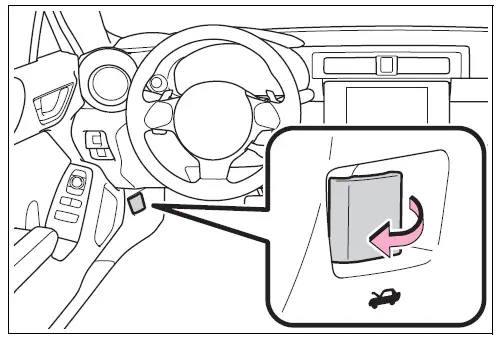
- The hood will pop up slightly. Push the auxiliary catch lever to the left and lift the hood

- Hold the hood open by inserting the support rod into the slot.
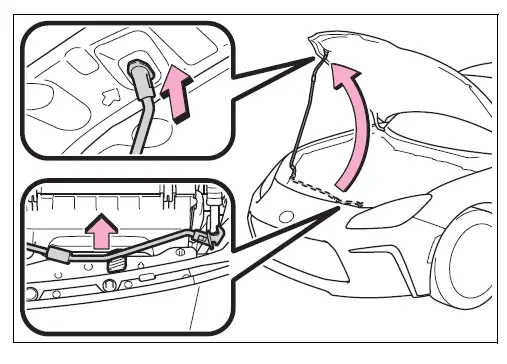
WARNING
- Pre-driving check
- Check that the hood is fully closed and locked.
- If the hood is not locked properly, it may open while the vehicle is in motion and cause an accident, which may result in death or serious injury.
NOTICE
- When opening the hood
- Do not lift up or operate the wipers.
- Doing so may cause the hood and wipers to contact, scratching the hood.
- Use caution when opening the hood in windy weather as it may close suddenly in strong wind.
- Do not attach any accessories other than genuine Toyota products to the hood. Such additional weight on the hood may cause it to be too heavy to be supported by the supporting rod when opened.
- When closing the hood
- Do not apply excessive weight or force when closing the hood as doing so may result in damage.
Positioning a floor jack
When using a floor jack, follow the instructions in the manual provided with the jack and perform the operation safely. When raising your vehicle with a floor jack, position the jack correctly. Improper placement may damage your vehicle or cause injury.
Location of the jack point
Front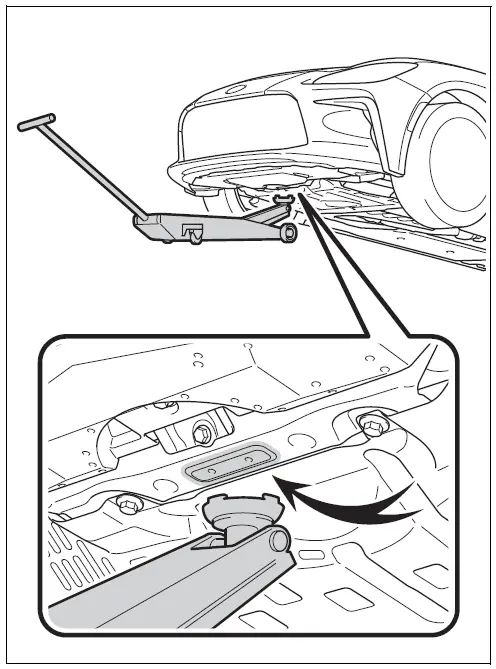 Rear
Rear
 Engine compartment
Engine compartment
Components
- Fuse boxes
- Battery
- Engine oil level dipstick
- Clutch fluid reservoir
- Engine oil filler cap
- Brake fluid reservoir
- Washer fluid tank
- Electric cooling fans
- Condenser
- Radiator
- Engine coolant reservoir
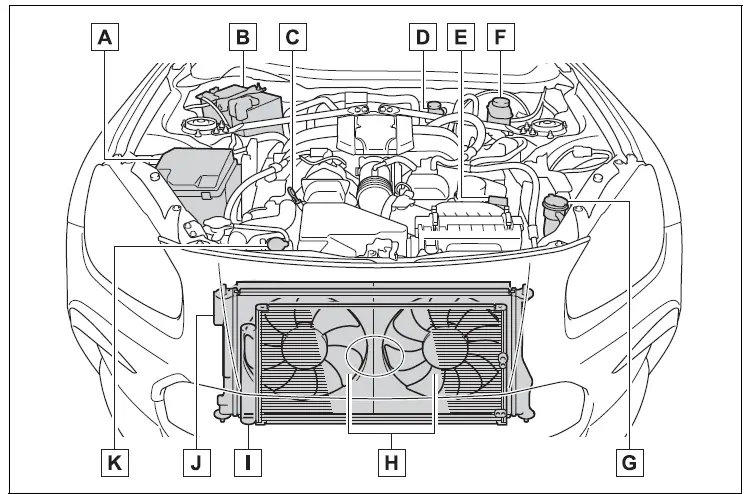
Checking and adding the engine oil
With the engine at operating temperature and turned off, check the oil level on the dipstick.
Checking the engine oil
- Park the vehicle on level ground. After warming up the engine and turning it off, wait more than 5 minutes for the oil to drain back into the bottom of the engine.
- Holding a rag under the end, pull the dipstick out
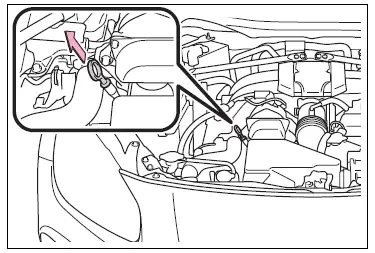
- Wipe the dipstick clean.
- Reinsert the dipstick fully.
- Holding a rag under the end, pull the dipstick out and check the oil level.
- When checking the oil, look at both sides of the dipstick and use the lower measurement to determine the level of oil.
- Wipe the dipstick and reinsert it fully.
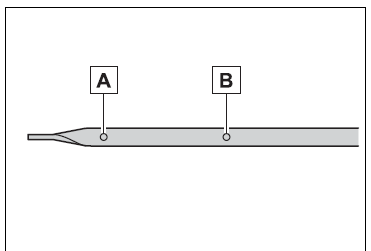
- Low
- Full
- Checking the oil type and preparing the item needed
- Make sure to check the oil type and prepare the items needed before adding oil.
- Engine oil selection
- P.382
- Oil quantity (Low Full) 1.1 qt. (1.0 L, 0.9 Imp. qt.)
- Item
- Clean funnel
- Engine oil selection
Adding engine oil
If the oil level is below or near the low level mark, add engine oil of the same type as that already in the engine.
- Remove the oil filler cap by turning it counterclockwise.
- Add engine oil slowly, checking the dipstick.
- Install the oil filler cap by turning it clockwise.
Engine oil consumption
- A certain amount of engine oil will be consumed while driving. In the following situations, oil consumption may increase, and engine oil may need to be refilled in between oil maintenance intervals.
- When the engine is new, for example directly after purchasing the vehicle or after replacing the engine
- If low quality oil or oil of an inappropriate viscosity is used
- When driving at high engine speeds or with a heavy load, or when driving while accelerating or decelerating frequently
- When leaving the engine idling for a long time, or when driving frequently through heavy traffic
WARNING
Used engine oil
- Used engine oil contains potentially harmful contaminants which may cause skin disorders such as inflammation and skin cancer, so care should be taken to avoid prolonged and repeated contact. To remove used engine oil from your skin, wash thoroughly with soap and water.
- Dispose of used oil and filters only in a safe and acceptable manner. Do not dispose of used oil and filters in household trash, in sewers or onto the ground. Call your Toyota dealer, service station or auto parts store for information concerning recycling or disposal.
- Do not leave used engine oil within the reach of children.
NOTICE
To prevent serious engine damage Check the oil level on a regular basis.
When replacing the engine oil
- Be careful not to spill engine oil on the vehicle components.
- Avoid overfilling, or the engine could be damaged.
- Check the oil level on the dipstick every time you refill the vehicle.
- Be sure the engine oil filler cap is properly tightened.
Checking the coolant
The coolant level is satisfactory if it is between the “FULL” and “LOW” lines on the reservoir when the engine is cold.
Engine coolant reservoir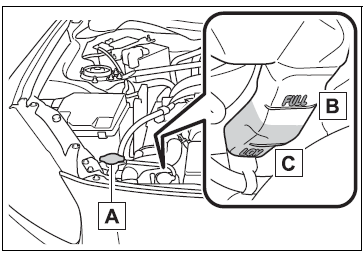
- Reservoir cap
- “FULL” line
- “LOW” line
If the level is on or below the “LOW” line, add coolant up to the “FULL” line.
Coolant selection
Only use “TOYOTA Genuine 50/50 Pre-mixed Super Long Life Coolant BLUE” or a similar high quality ethylene glycol based non-silicate, non-amine, non-nitrite, and non-borate coolant with long-life hybrid organic acid technology. U.S.A.: “TOYOTA Genuine 50/50 Pre-mixed Super Long Life Coolant BLUE” is a mixture of 50% coolant and 50% deionized water. (Minimum temperature: -31°F [-35°C]) Canada: “TOYOTA Genuine 50/50 Pre-mixed Super Long Life Coolant BLUE” is a mixture of 55% coolant and 45% deionized water. (Minimum temperature: -44°F [-42°C]) For more details about coolant, contact your Toyota dealer.
If the coolant level drops within a short time of replenishing
Visually check the radiator, hoses, engine coolant reservoir caps, drain cock and water pump. If you cannot find a leak, have your Toyota dealer test the cap and check for leaks in the cooling system.
WARNING
When the engine is hot Do not remove the engine coolant reservoir cap. The cooling system may be under pressure and may spray hot coolant if the cap is removed, causing serious injuries, such as burns.
NOTICE
When adding coolant Coolant is neither plain water nor straight antifreeze. The correct mixture of water and antifreeze must be used to provide proper lubrication, corrosion protection and cooling. Be sure to read the antifreeze or coolant label
If you spill coolant
Be sure to wash it off with water to prevent it from damaging parts or paint.
Checking the radiator and condenser
Check the radiator and condenser and clear away any foreign objects. If either of the above parts is extremely dirty or you are not sure of their condition, have your vehicle inspected by your Toyota dealer.
WARNING
When the engine is hot Do not touch the radiator or condenser as they may be hot and cause serious injuries, such as burns.
Checking and adding the brake fluid and clutch fluid
Checking fluid level The brake fluid and clutch fluid level should be between the “MAX” and “MIN” lines on the tank
Brake Fluid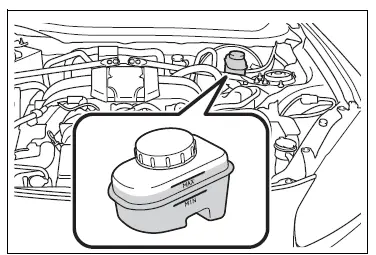 Clutch fluid
Clutch fluid
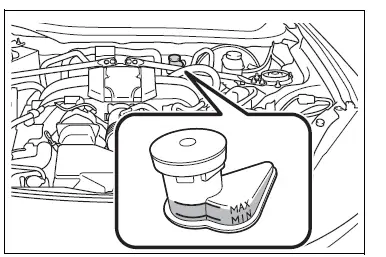
Adding fluid
Make sure to check the fluid type and prepare the necessary item.
- Fluid type SAE J1703 or FMVSS No.116 DOT 3
- Item Clean funnel
Brake fluid can absorb moisture from the air
Excess moisture in the brake fluid can cause a dangerous loss of braking efficiency. Use only newly opened brake fluid.
WARNING
When filling the reservoir Take care as brake fluid and clutch fluid can harm your hands and eyes and damage painted surfaces. If fluid gets on your hands or in your eyes, flush the affected area with clean water immediately. If you still experience discomfort, see a doctor.
NOTICE
- If the fluid level is low or high It is normal for the brake fluid level to go down slightly as the brake pads wear out or when the fluid level in the accumulator is high.
- If the reservoir needs frequent refilling, there may be a serious problem.
Battery
Check the battery as follows.
Battery exterior
Make sure that the battery terminals are not corroded and that there are no loose connections, cracks, or loose clamps.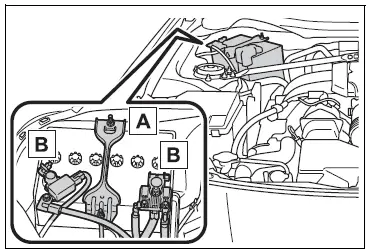
- Hold-down clamp
- Terminals
Checking battery fluid
Check that the level is between the “UPPER LEVEL” and “LOWER LEVEL” lines
- UPPER LEVEL” line
- “LOWER LEVEL” line
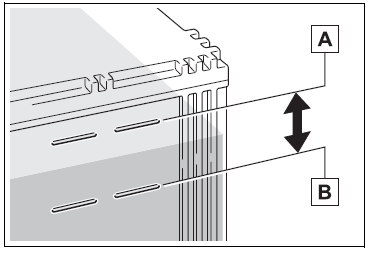
If the fluid level is at or below the “LOWER LEVEL” line, add distilled water.
Adding distilled water
- Remove the vent plug.
- Add distilled water
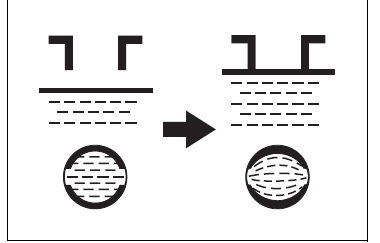
- If the “UPPER LEVEL” line cannot be seen, check the fluid level by looking directly at the cell.
- Put the vent plug back on and close it securely
Before recharging
- When recharging, the battery produces hydrogen gas which is flammable and explosive. Therefore observe the following before recharging:
- If recharging with the battery installed on the vehicle, be sure to disconnect the ground cable.
- Make sure the power switch on the charger is off when connecting and disconnecting the charger cables to the battery.
- After recharging/reconnecting the battery
The engine may not start. Follow the procedure below to initialize the system.
- Shift the shift lever to P (automatic transmission) or depress the brake pedal with the shift lever in N (manual transmission).
- Open and close either door.
- Restart the engine
- Unlocking the doors using the smart key system may not be possible immediately after reconnecting the battery. If this happens, use the wireless remote control or the mechanical key to lock/unlock the doors.
- Start the engine with the engine switch in ACC. The engine may not start with the engine switch turned off. However, the engine will operate normally from the second attempt.
- The engine switch mode is recorded by the vehicle. If the battery is disconnected and reconnected, the vehicle will return the engine switch mode to the status it was in before the battery was disconnected. Make sure to turn off the engine before disconnecting the battery. Take extra care when connecting the battery if the engine switch mode prior to the battery being disconnected is unknown. If the system will not start even after multiple attempts, contact your Toyota dealer.
WARNING.
Chemicals in the battery
Batteries contain poisonous and corrosive sulfuric acid and may produce hydrogen gas which is flammable and explosive. To reduce the risk of death or serious injury, take the following precautions while working on or near the battery:
- Do not cause sparks by touching the battery terminals with tools.
- Do not smoke or light a match near the battery.
- Avoid contact with eyes, skin and clothes.
- Never inhale or swallow electrolyte.
- Wear protective safety glasses when working near the battery.
- Keep children away from the battery.
Where to safely charge the battery
Always charge the battery in an open area. Do not charge the battery in a garage or closed room where there is insufficient ventilation.
Emergency measures regarding electrolyte
- If electrolyte gets in your eyes Flush your eyes with clean water for at least 15 minutes and get immediate medical attention.
- If possible, continue to apply water with a sponge or cloth while traveling to the nearest medical facility. If electrolyte gets on your skin Wash the affected area thoroughly.
- If you feel pain or burning, get medical attention immediately.
- If electrolyte gets on your clothes It can soak through clothing onto your skin. Immediately take off the clothing and follow the procedure above if necessary.
- If you accidentally swallow electrolyte Drink a large quantity of water or milk. Get emergency medical attention immediately.
NOTICE
- When recharging the battery Never recharge the battery while the engine is running. Also, be sure all accessories are turned off.
- When adding distilled water Avoid overfilling. Water spilled during battery recharging may cause corrosion.
Adding the washer fluid
If the washer fluid level is at “LOW”, add washer fluid.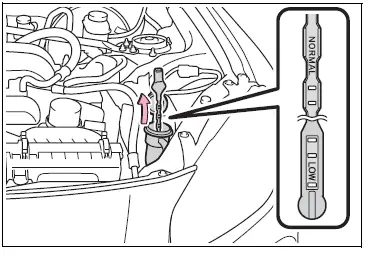
Using the gauge
The washer fluid level can be checked by observing the position of the level on the liquid-covered holes in the gauge. If the level falls below the second hole from the bottom (the “LOW” position), refill the washer fluid.
- Current fluid level
WARNING
When adding washer fluid Do not add washer fluid when the engine is hot or running as washer fluid contains alcohol and may catch fire if spilled on the engine, etc.
NOTICE
- Do not use any fluid other than washer fluid Do not use soapy water or engine antifreeze instead of washer fluid. Doing so may cause streaking on the vehicle’s painted surfaces, as well as damaging the pump leading to problems of the washer fluid not spraying.
- Diluting washer fluid Dilute washer fluid with water as necessary. Refer to the freezing temperatures listed on the label of the washer fluid bottle
2023 Toyota GR86 Specs, Price, Features and Mileage (Brochure)
Tyres
Replace or rotate tires in accordance with maintenance schedules and treadwear.
Checking tyres
Check if the treadwear indicators are showing on the tires. Also check the tires for uneven wear, such as excessive wear on one side of the tread. Check the spare tire condition and pressure if not rotated.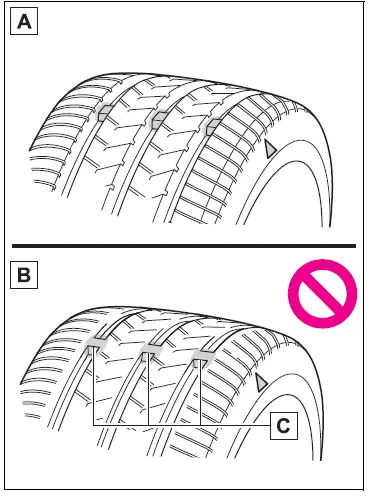
- New tread
- Worn tread
- Treadwear indicator
The location of treadwear indicators is shown by a “TWI” or ![]() mark, etc., moulded into the sidewall of each tire. Replace the tires if the treadwear indicators are showing on a tire.
mark, etc., moulded into the sidewall of each tire. Replace the tires if the treadwear indicators are showing on a tire.
When to replace your vehicle’s tires
Tires should be replaced if:
- The treadwear indicators are showing on a tire.
- You have tire damage such as cuts, splits, cracks deep enough to expose the fabric, and bulges indicating internal damage
- A tire goes flat repeatedly or cannot be properly repaired due to the size or location of a cut or other damage If you are not sure, consult your Toyota dealer.
Tire life
Any tire over 6 years old must be checked by a qualified technician even if it has seldom or never been used or damage is not obvious.
Low profile tires
Generally, low-profile tires will wear more rapidly and tire grip performance will be reduced on snowy and/or icy roads when compared to standard tires. Be sure to use snow tires or tire chains on snowy and/or icy roads and drive carefully at a speed appropriate for road and weather conditions.
Maximum load of tire
Check that the maximum load of the replacement tire is greater than 1/2 of the Gross Axle Weight Ratings (GAWR) of either the front axle or the rear axle, whichever is greater. For the GAWR, see the Certification Label. For the maximum load of the tire, see the load limit at maximum cold tire inflation pressure mentioned on the sidewall of the tire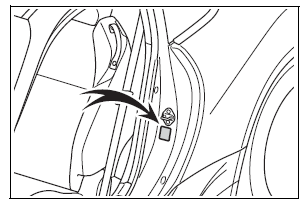
Tyre types
Summer tires
Summer tires are high-speed performance tires best suited to highway driving under dry conditions. Since summer tires do not have the same traction performance as snow tires, summer tires are inadequate for driving on snow-covered or icy roads. For driving on snow-covered roads or icy roads, the use of snow tires is recommended. When installing snow tires, be sure to replace all four tires.
All season tires
are designed to provide better traction in snow and to be adequate for driving in most winter conditions as well as for use year-round. All season tires, however, do not have adequate traction performance compared with snow tires in heavy or loose snow. Also, all-season tires fall short in acceleration and handling performance compared with summer tires in highway driving.
Snow tires
For driving on snow-covered roads or icy roads, we recommend using snow tires. If you need snow tires, select tires of the same size, construction and load capacity as the originally installed tires. Since your vehicle has radial tires as original equipment, make sure your snow tires also have radial construction. Do not install studded tires without first checking local regulations for possible restrictions. Snow tires should be installed on all wheels.
If the tread on snow tires wears down below 0.16 in. (4 mm)
The effectiveness of the tires as snow tires is lost
WARNING
- When inspecting or replacing tires Observe the following precautions to prevent accidents. Failure to do so may cause damage to parts of the drive train as well as dangerous handling characteristics, which may lead to an accident resulting in death or serious injury.
- Make sure to install 4 tires that are of the specified size, and that all 4 tires are the same size, same maker, same brand and tread pattern.
- Do not use tire sizes other than those recommended by Toyota.
- Only use radial tires.
- Do not mix summer, all-season and snow tires.
- Do not use tires that have been used on another vehicle. Do not use tires if you do not know how they were used previously.
NOTICE
Low profile tires
- Low-profile tires may cause greater damage than usual to the tire wheel when sustaining impact from the road surface. Therefore, pay attention to the following:
- Be sure to use proper tire inflation pressure. If tires are under-inflated, they may be damaged more severely.
- Avoid potholes, uneven pavement, curbs and other road hazards. Failure to do so may lead to severe tire and wheel damage.
- If tire inflation pressure of each tire becomes low while driving Do not continue driving, or your tires and/or wheels may be ruined.
- Driving on rough roads Take particular care when driving on roads with loose surfaces or potholes. These conditions may cause losses in tire inflation pressure, reducing the cushioning ability of the tires. In addition, driving on rough roads may cause damage to the tires themselves, as well as the vehicle’s wheels and body.
Tire rotation
Rotate the tires in the order shown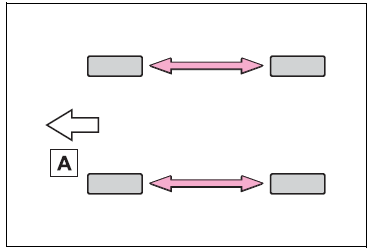
Front
To equalize tire wear and extend tire life, Toyota recommends that tire rotation is carried out at the same interval as tire inspection.
Tire pressure warning system
Your vehicle is equipped with a tire pressure warning system that uses tire pressure warning valves and transmitters to detect low tire inflation pressure before serious problems arise.
- The tire pressure detected by the tire pressure warning system can be displayed on the multi-information display

- If the tire pressure drops below a predetermined level, the driver is warned by a screen display and a warning light.

Routine tire inflation pressure checks
The tire pressure warning system does not replace routine tire inflation pressure checks. Make sure to check tire inflation pressure as part of your routine of daily vehicle checks.
Tire inflation pressure
- It may take a few minutes to display the tire inflation pressure after the engine switch is turned to ON.
- It may also take a few minutes to display the tire inflation pressure after inflation pressure has been adjusted.
- Tire inflation pressure changes with temperature. The displayed values may also be different from the values measured using a tire pressure gauge.
- Situations in which the tire pressure warning system may not operate properly
- In the following cases, the tire pressure warning system may not operate properly.
- If non-genuine Toyota wheels are used.
- A tire has been replaced with a tire that is not an OE (Original Equipment) tire.
- A tire has been replaced with a tire that is not of the specified size.
- Tire chains, etc. are equipped.
- An auxiliary-supported run-flat tire is equipped.
- If a window tint that affects the radio wave signals is installed.
- If there is a lot of snow or ice on the vehicle, particularly around the wheels or wheel housings.
- If the tire inflation pressure is extremely higher than the specified level.
- If tires not equipped with tire pressure warning valves and transmitters are used.
- If the ID code on the tire pressure warning valves and transmitters is not registered in the tire pressure warning computer.
- Performance may be affected in the following situations.
- When driving near a TV tower, electric power plant, gas station, radio station, large display, airport, or another facility that generates strong radio waves or electrical noise
- When carrying a portable radio, cellular phone, cordless phone or another wireless communication device If tire position information is not correctly displayed due to the radio wave conditions, the display may be corrected by driving and changing the radio wave conditions.
- When the vehicle is parked, the time taken for the warning to start or go off could be extended.
- When tire inflation pressure declines rapidly for example when a tire has burst, the warning may not function.
Warning performance of the tire pressure warning system
- The warning of the tire pressure warning system will change in accordance with driving conditions. For this reason, the system may give a warning even if the tire pressure does not reach a low enough level, or if the pressure is higher than the pressure that was adjusted to when the system was initialized.
Installing tire pressure warning valves and transmitters
When replacing tires or wheels, tire pressure warning valves and transmitters must also be installed. When new tire pressure warning valves and transmitters are installed, new ID codes must be registered in the tire pressure warning computer and the tire pressure warning system must be initialized. Have tire pressure warning valve and transmitter ID codes registered by your Toyota dealer
Replacing tires and wheels
If the ID code of the tire pressure warning valve and transmitter is not registered, the tire pressure warning system will not work properly. After driving for about 20 minutes, the tire pressure warning light blinks for 1 minute and stays on to indicate a system malfunction.
NOTICE
- Repairing or replacing tires, wheels, tire pressure warning valves, transmitters, and tire valve caps
- When removing or fitting the wheels, tires, or the tire pressure warning valves and transmitters, contact your Toyota dealer as the tire pressure warning valves and transmitters may be damaged if not handled correctly.
NOTICE
- Make sure to install the tire valve caps. If the tire valve caps are not installed, water could enter the tire pressure warning valves and the tire pressure warning valves could be bound.
- When replacing tire valve caps, do not use tire valve caps other than those specified. The cap may become stuck.
- To avoid damage to the tire pressure warning valves and transmitters
- When a tire is repaired with liquid sealants, the tire pressure warning valve and transmitter may not operate properly.
- If a liquid sealant is used, contact your Toyota dealer or another qualified service shop as soon as possible.
- After use of liquid sealant, make sure to replace the tire pressure warning valve and transmitter when repairing or replacing the tire.
Initializing the tire pressure warning system
- The tire pressure warning system must be initialized in the following circumstances:
- When rotating the tires.
- When the tire inflation pressure is changed such as when changing traveling speed.
- When changing the tire size.
- When the tire pressure warning system is initialized, the current tire inflation pressure is set as the benchmark pressure.
How to initialize the tire pressure warning system
- Park the vehicle in a safe place and turn the engine switch off. Initialization cannot be performed while the vehicle is moving.
- Adjust the tire inflation pressure to the specified cold tire inflation pressure level. Make sure to adjust the tire pressure to the specified cold tire inflation pressure level.
- The tire pressure warning system will operate based on this pressure level.
- Turn the engine switch to ON. 4 Press and hold the tire pressure warning reset switch until the tire pressure warning light blinks slowly 3 times. then turn the engine switch off.

If you press the tire pressure warning reset switch accidentally
If initialization is performed, adjust the tire inflation pressure to the specified level and initialize the tire pressure warning system again.
Initialization procedure
- Make sure to carry out initialization after adjusting the tire inflation pressure. Also, make sure the tires are cold before carrying out initialization or tire inflation pressure adjustment.
- If you have accidentally turned the engine switch off during initialization, it is not necessary to press the reset switch again as initialization will restart automatically when the engine switch has been turned to ON for the next time.
- If you accidentally press the reset switch when initialization is not necessary, adjust the tire inflation pressure to the specified level when the tires are cold, and conduct initialization again.
- When initialization of the tire pressure warning system has failed Initialization can be completed in a few minutes. However, in the following cases, the settings have not been recorded and the system will not operate properly. If repeated attempts to record tire inflation pressure settings are unsuccessful, have the vehicle inspected by your Toyota dealer.
- When operating the tire pressure warning reset switch, tire pressure warning light does not blink 3 times.
- After carrying out the initialization procedure, the tire pressure warning light blinks for 1 minute then stays on after driving for 20 minutes.
WARNING
When initializing the tire pressure warning system Do not operate the tire pressure warning reset switch without first adjusting the tire inflation pressure to the specified level. Otherwise, the tire pressure warning light may not come on even if the tire inflation pressure is low, or it may come on when the tire inflation pressure is actually normal
Registering ID codes
The tire pressure warning valve and transmitter is equipped with a unique ID code. When replacing a tire pressure warning valve and transmitter, it is necessary to register the ID code. Have the ID code registered by your Toyota dealer.
Registering ID codes
The ID codes of the tire pressure warning valve and transmitters for two sets of wheels can be registered. It is not necessary to register the ID codes when replacing normal tires with snow tires, if the ID codes for the wheels of both normal tires and snow tires are registered beforehand. In addition to the set of tire pressure warning system sensor ID codes initially registered to the vehicle, a second set of ID codes can be registered. A second set of tire pressure warning system sensor ID codes can be registered at your Toyota dealer. When 2 sets of ID codes have been registered, either ID code set can be selected.
Changing the ID code set
- Park the vehicle in a safe place and turn the engine switch to ON.
- Press the tire pressure warning reset switch 3 times within 3 seconds.
- The tire pressure warning light will illuminate for 3 seconds and then blink 3 times.
- The tire pressure warning light will blink for 1 minute and then illuminate.
- When the ID code change has been completed, the tire pressure warning light will turn off.
Check that tire pressures are displayed on the multi-information display.
Replacing the tire
When raising your vehicle with a jack, position the jack correctly. Improper placement may damage your vehicle or cause injury. If necessary tire replacement seems difficult to perform, contact your Toyota dealer.
Before jacking up the vehicle
- Stop the vehicle in a safe place on a hard, flat surface.
- Set the parking brake.
- Shift the shift lever to P (automatic transmission) or R (manual transmission).
- Stop the engine.
Jack and Jack handle
As your vehicle is equipped with an emergency tire puncture repair kit, a jack and jack handle for replacing a tire are not included with your vehicle. To purchase a jack and jack handle, contact your Toyota dealer.
- Jack
- Jack handle
Location of the jack and tools
- Towing eyelet
- Screwdriver
- Jack handle (if equipped)
- Wheel nut wrench
- Jack (if equipped)
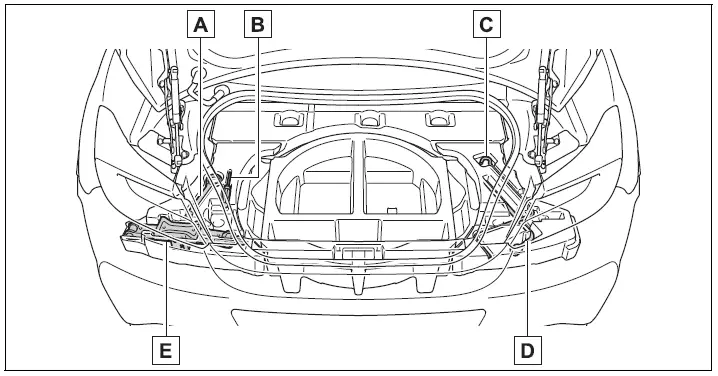
- Jack (if equipped)
WARNING
- Using the tire jack Observe the following precautions. Improper use of the tire jack may cause the vehicle to suddenly fall off the jack, leading to death or serious injury.
- Do not use the tire jack for any purpose other than replacing tires or installing and removing tire chains.
- Do not use other tire jacks for replacing tires on this vehicle.
- Always check that the tire jack is securely set to the jack point.
- Do not put any part of your body under the vehicle while it is supported by the jack.Do not start the engine or drive the vehicle while the vehicle is supported by the jack.
- Do not raise the vehicle while someone is inside.
- When raising the vehicle, do not put an object on or under the jack.
- Do not raise the vehicle to a height greater than that required to replace the tire.
- Use a jack stand if it is necessary to get under the vehicle.
- When lowering the vehicle, make sure that there is no-one near the vehicle. If there are people nearby, warn them vocally before lowering.
Removing a tire
- Chock the tires.

| Flat tire | Wheel chock positions |
| Front left-hand side | Behind the rear right-hand side tire |
| Front right-hand side | Behind the rear left-hand side tire |
| Rear left-hand side | In front of the front right-hand side tire |
| Rear right-hand side | In front of the front left-hand side tire |
- Slightly loosen the wheel nuts (one turn).
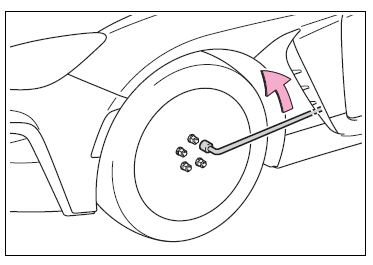
- Turn the tire jack portion by hand until the notch of the jack is in contact with the jack point.
- Raise the vehicle until the tire is slightly raised off the ground.
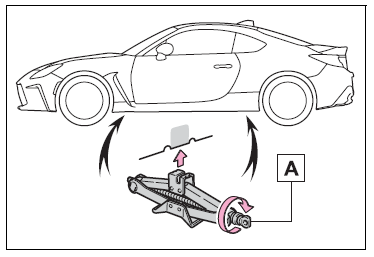
- Remove all the wheel nuts and the tire.
- When resting the tire on the ground, place the tire so that the wheel design faces up to avoid scratching the wheel surface.
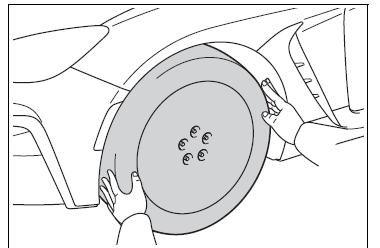
WARNING
Replacing a flat tire Do not touch the disc wheels or the area around the brakes immediately after the vehicle has been driven. After the vehicle has been driven the disc wheels and the area around the brakes will be extremely hot. Touching these areas with hands, feet or other body parts while changing a tire, etc. may result in burns.
Installing the tyre
- Remove any dirt or foreign matter from the wheel contact surface.
- If foreign matter is on the wheel contact surface, the wheel nuts may loosen while the vehicle is in motion, causing the tire to come off.

- If foreign matter is on the wheel contact surface, the wheel nuts may loosen while the vehicle is in motion, causing the tire to come off.
- Install the tire and loosely tighten each wheel nut by hand by approximately the same amount.
- Turn the wheel nuts until the washers come into contact with the disc wheel.

- Tapered portion
- Disc wheel
- Turn the wheel nuts until the washers come into contact with the disc wheel.
- Lower the vehicle
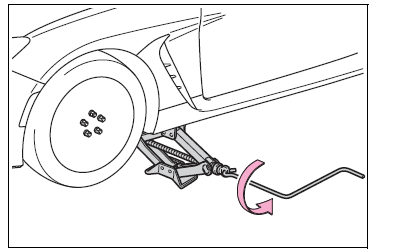
- Firmly tighten each wheel nut two or three times in the order shown in the illustration.
- Tightening torque:
- 89 ft•lbf (120 N•m, 12.2 kgf•m)

- 89 ft•lbf (120 N•m, 12.2 kgf•m)
- Tightening torque:
- Stow the jack and all tools.
WARNING
- When installing the tire Failure to follow these precautions could cause the wheel nuts to loosen and the tire to fall off, resulting in death or serious injury.
- Never use oil or grease on the wheel bolts or wheel nuts. Oil and grease may cause the wheel nuts to be excessively tightened, leading to bolt or disc wheel damage. In addition, the oil or grease can cause the wheel nuts to loosen and the wheel may fall off, causing a serious accident. Remove any oil or grease from the wheel bolts or wheel nuts.
- Have the wheel nuts tightened with a torque wrench to 89 ft•lbf (120 N•m, 12.2 kgf•m) as soon as possible after changing wheels.
- Do not attach a heavily damaged wheel ornament, as it may fly off the wheel while the vehicle is moving.
- When installing a tire, only use wheel nuts that have been specifically designed for that wheel.
- If there are any cracks or deformations in the bolt screws, nut threads or bolt holes of the wheel, have the vehicle inspected by your Toyota dealer.
Tire inflation pressure
Checking the specified tire inflation pressure
The recommended cold tire inflation pressure and tire size are displayed on the tire and loading information label.
Inspection and adjustment procedure
Tire pressure gauge
- Remove the tire valve cap.
- Press the tip of the tire pressure gauge onto the tire valve.
- Read the pressure using the gauge gradations.
- If the tire inflation pressure is not at the recommended level, adjust the pressure. If you add too much air, press the center of the valve to deflate.
- After completing the tire inflation pressure measurement and adjustment, apply soapy water to the valve and check for leakage.
- Put the tire valve cap back on.
Tire inflation pressure check interval
You should check tire inflation pressure every two weeks, or at least once a month.
- Effects of incorrect tire inflation pressure Driving with incorrect tire inflation pressure may result in the following:
- Reduced fuel economy
- Reduced driving comfort and poor handling
- Reduced tire life due to wear
- Reduced safety
- Damage to the drivetrain If a tire needs frequent inflating, have it checked by your Toyota dealer. Instructions for checking tire inflation pressure When checking tire inflation pressure, observe the following:
- Check only when the tires are cold. If your vehicle has been parked for at least 3 hours or has not been driven for more than 1 mile or 1.5 km, you will get an accurate cold tire inflation pressure reading.
- Always use a tire pressure gauge. It is difficult to judge if a tire is properly inflated based only on its appearance.
- It is normal for the tire inflation pressure to be higher after driving as heat is generated in the tire. Do not reduce tire inflation pressure after driving.
- Never exceed the vehicle capacity weight. Passengers and luggage weight should be placed so that the vehicle is balanced.
WARNING
Proper inflation is critical to save tire performance Keep your tires properly inflated. If the tires are not properly inflated, the following conditions may occur which could lead to an accident resulting in death or serious injury:
- Excessive wear
- Uneven wear
- Poor handling
- Possibility of blowouts resulting from overheated tires
- Air leaking from between tire and wheel
- Wheel deformation and/or tire damage
Greater possibility of tire damage while driving (due to road hazards, expansion joints, sharp edges in the road, etc.)
NOTICE
When inspecting and adjusting tire inflation pressure Be sure to put the tire valve caps back on.If a valve cap is not installed, dirt or moisture may get into the valve and cause an air leak, resulting in decreased tire inflation pressure.
Wheels
If a wheel is bent, cracked or heavily corroded, it should be replaced. Otherwise, the tire may separate from the wheel or cause a loss of handling control.
Wheel selection
When replacing wheels, care should be taken to ensure that they are equivalent to those removed in load capacity, diameter, rim width and inset*. Replacement wheels are available at your Toyota dealer. *: Conventionally referred to as offset. Toyota does not recommend using the following:
- Wheels of different sizes or types
- Used wheels
- Bent wheels that have been straightened
When replacing wheels
The wheels of your vehicle are equipped with tire pressure warning valves and transmitters that allow the tire pressure warning system to provide advance warning in the event of a loss in tire inflation pressure. Whenever wheels are replaced, tire pressure warning valves and transmitters must be installed.
WARNING
- Do not use wheels that are a different size from those recommended in the Owner’s Manual maintenance instructions, as this may result in a loss of handling control.
- Never use an inner tube in a leaking wheel that is designed for a tubeless tire. Doing so may result in an accident, causing death or serious injury.
When installing the wheel nuts
- Never use oil or grease on the wheel bolts or wheel nuts. Oil and grease may cause the wheel nuts to be excessively tightened, leading to bolt or disc wheel damage. In addition, the oil or grease can cause the wheel nuts to loosen and the wheel may fall off, causing an accident and resulting in death or serious injury. Remove any oil or grease from the wheel bolts or wheel nuts.
Use of defective wheels prohibited
- Do not use cracked or deformed wheels. Doing so could cause the tire to leak air during driving, possibly causing an accident.
NOTICE
DIY Toyota 86 service tips
- Replacing tire pressure warning valves and transmitters
- Because tire repair or replacement may affect the tire pressure warning valves and transmitters, make sure to have tires serviced by your Toyota dealer or another qualified service shop.
- In addition, make sure to purchase your tire pressure warning valves and transmitters at your Toyota dealer
- Ensure that only genuine Toyota wheels are used on your vehicle. Tire pressure warning valves and transmitters may not work properly with non-genuine wheels.
Aluminum wheel precautions
- Use only Toyota wheel nuts and wrenches designed for use with your aluminium wheels.
- When rotating, repairing or changing your tires, check that the wheel nuts are still tight after driving 1000 miles (1600 km).
- Be careful not to damage the aluminium wheels when using tire chains.
- Use only Toyota genuine balance weights or equivalent and a plastic or rubber hammer when balancing your wheels.
Air conditioning filter
The air conditioning filter must be changed regularly to maintain air conditioning efficiency.
Removing the air conditioning filter
- Turn the engine switch off.
- Open the glove box. Slide off the damper

- Push in each side of the glove box and pull the glove box toward you to disconnect the claws.

- Lower the glove box slowly until surface ( ) is horizontal with the floor, then pull it out. (Simply pulling with gentle force will disengage the lower claws.)
- Do not forcibly pull the glove box.
- Otherwise, the lower claws ( ) or the lower claw engagement points ( ) may be deformed, making it difficult to reinstall or close the glove box.
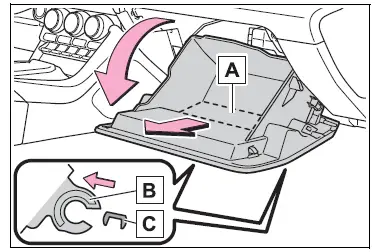
- Remove the filter cover.
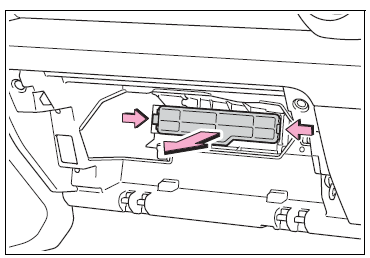
- Remove the air conditioning filter and replace it with a new one.
- The “ UP” marks shown on the filter and the filter case should be pointing up.
- Remove the air conditioning filter and replace it with a new one.
- The “ UP” marks shown on the filter and the filter case should be pointing up. When installing, reverse the steps listed
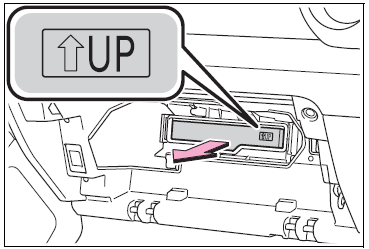
Checking interval
Inspect and replace the air conditioning filter according to the maintenance schedule. In dusty areas orareas with heavy traffic flow, early replacement may be required. (For scheduled maintenance information, please refer to the “Owner’s Manual Supplement” or “Scheduled Maintenance”.)
If airflow from the vents decreases dramatically
The filter may be clogged. Check the filter and replace if necessary
NOTICE
- When removing the glove box
- Do not forcibly pull the glove box. Otherwise, the lower claws or the lower claw engagement points may be deformed, making it difficult to reinstall or close the glove box.
- When using the air conditioning system
- Make sure that a filter is always installed. Using the air conditioning system without a filter may cause damage to the system.
Electronic key battery
Replace the battery with a new one if it is depleted. As the key may be damaged if the following procedure is not performed properly, it is recommended that key battery replacement be performed by your Toyota dealer.
If the electronic key battery is depleted
- The following symptoms may occur:
- The smart key system and wireless remote control will not function properly.
- The operational range will be reduced.
Items to prepare
- Flathead screwdriver
- Lithium battery CR2032
Use a CR2032 lithium battery
- Batteries can be purchased at your Toyota dealer, local electrical appliance shops or camera stores.
- Replace only with the same or equivalent type recommended by the manufacturer.
- Dispose of used batteries according to local laws.
Replacing the battery
- Take out the mechanical key.
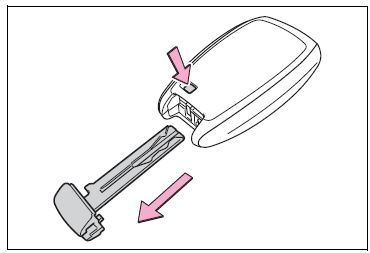
- Insert the tip of a flathead screwdriver into the groove ( ) and remove the cover.
- To prevent damage to the key, cover the tip of the flathead screwdriver with a rag.

- Remove the depleted battery.
- To prevent damage to the key, cover the tip of the flathead screwdriver with a rag.
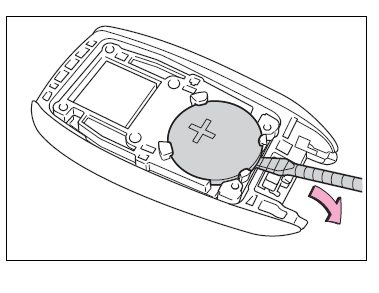
- Install a new battery with the “+” terminal facing up, as shown in the illustration
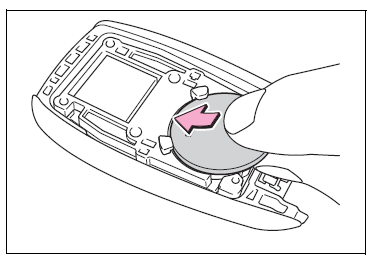
- Align the protruding part with the slot and install the cover
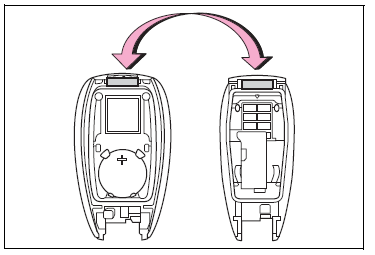
WARNING
- Battery precautions
- Observe the following precautions.
- Failure to do so may result in death or serious injury.
- Do not swallow the battery.
- Doing so may cause chemical burns.
- A coin battery or button battery is used in the electronic key.
- If a battery is swallowed, it may cause severe chemical burns in as little as 2 hours and may result in death or serious injury.
- Keep away new and removed batteries from children.
- If the cover cannot be firmly closed, stop using the electronic key and stow the key in the place where children cannot reach, and then contact your Toyota dealer.
- If you accidentally swallow a battery or put a battery into a part of your body, get emergency medical attention immediately.
- To prevent battery explosion or leakage of flammable liquid or gas
- Replace the battery with a new battery of the same type. If the wrong type of battery is used, it may explode.
- Do not expose batteries to extremely low pressure due to high altitude or extremely high temperatures.
- Do not burn, break or cut a battery.
NOTICE
- For normal operation after replacing the battery
- Observe the following precautions to prevent accidents:
- Always work with dry hands.
- Moisture may cause the battery to rust.
- Do not touch or move any other component inside the remote control.
- Do not bend either of the battery terminals.
Checking and replacing fuses
If any of the electrical components do not operate, a fuse may have blown. If this happens, check and replace the fuses as necessary
Checking and replacing fuses
- Turn the engine switch off.
- Open the fuse box cover.
Engine compartment
Push the tab in and lift the lid off.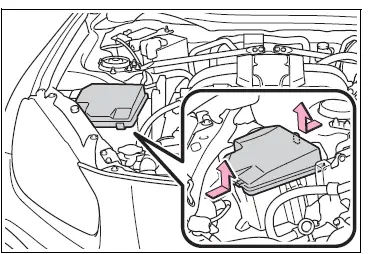
Instrument panel
- Remove the lid.

- 3 Remove the fuse with the pullout tool.
Only type A fuses can be removed using the pullout tool.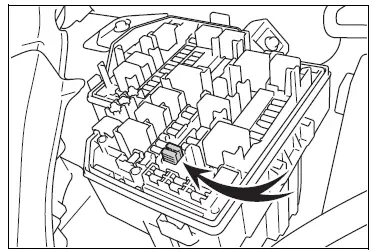
Check if the fuse is blown.
Type A and B:
Replace the blown fuse with a new fuse of an appropriate amperage rating. The amperage rating can be found on the fuse box lid.
Type C:
Contact your Toyota dealer.
Type A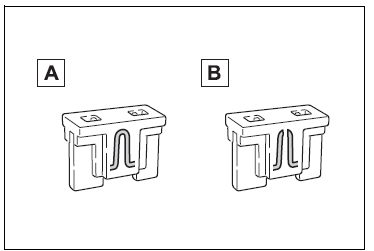
- Normal fuse
- Blown fuse
Type B
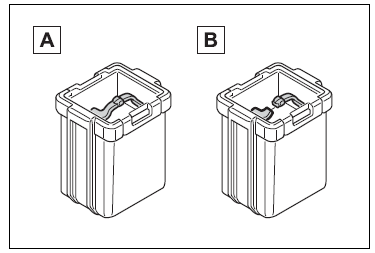
- Normal fuse
- Blown fuse
Type C
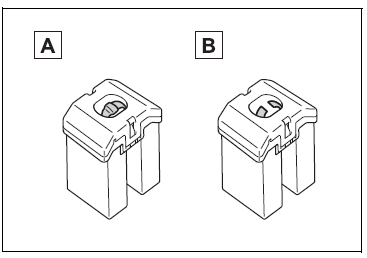
- Normal fuse
- Blown fuse
After a fuse is replaced
- If the lights do not turn on even after the fuse has been replaced, a bulb may need replacement.
- If the replaced fuse blows again, have the vehicle inspected by your Toyota dealer.
- If there is an overload in a circuit
- The fuses are designed to blow, protecting the wiring harness from damage.
- When replacing light bulbs
- Toyota recommends that you use genuine Toyota products designed for this vehicle.
- Because certain bulbs are connected to circuits designed to prevent overload, non-genuine parts or parts not designed for this vehicle may be unusable
WARNING
- To prevent system breakdowns and vehicle fire
- Observe the following precautions.
- Failure to do so may cause damage to the vehicle, and possibly a fire or injury.
- Never use a fuse of a higher amperage rating than that indicated, or use any other object in place of a fuse.
- Always use a genuine Toyota fuse or equivalent. Never replace a fuse with a wire, even as a temporary fix.
- Do not modify the fuses or fuse boxes.
NOTICE
- Before replacing fuses
- Have the cause of electrical overload determined and repaired by your Toyota dealer as soon as possible.
Headlight aim
Vertical movement adjusting bolts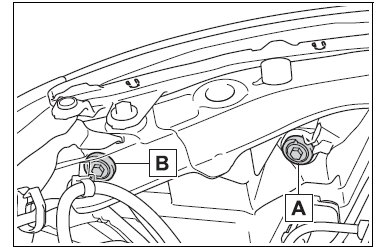
- Adjustment bolt A
- Adjustment bolt B
Before checking the headlight aim
- Make sure the vehicle has a full tank of gasoline and the area around the headlight is not deformed.
- Park the vehicle on level ground.
- Make sure the tire inflation pressure is at the specified level.
- Have someone sit in the driver’s seat.
- Bounce the vehicle several times.
Adjusting the headlight aim
- Using a Phillips-head screwdriver, turn bolt A in either direction.
- Remember the turning direction and the number of turns.
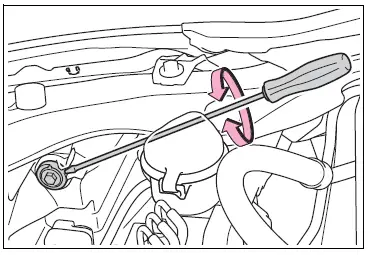
- Turn bolt B the same number of turns and in the same direction as step 1.
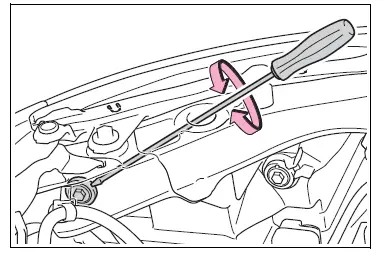
- If the headlight cannot be adjusted using this procedure, take the vehicle to your Toyota dealer to adjust the headlight aim.
Light bulbs
You may replace the following bulbs by yourself. The difficulty level of replacement varies depending on the bulb. If necessary bulb replacement seems difficult to perform, contact your Toyota dealer.
Preparing for light bulb replacement
Check the wattage of the light bulb to be replaced.
Bulb locations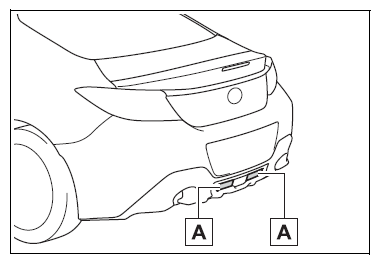
Back-up light
- Bulbs that need to be replaced by your Toyota dealer
- Headlights
- Parking lights/daytime running lights
- Front turn signal lights
- Side marker lights
- Stop/tail lights
- Rear turn signal lights
- High mounted stoplight
- License plate lights
- Door courtesy lights (if equipped)
LED light bulbs
The lights other than the back-up light each consist of a number of LEDs. If any of the LEDs burn out, take your vehicle to your Toyota dealer to have the light replaced.
Condensation build-up on the inside of the lens
Temporary condensation build-up on the inside of the headlight lens does not indicate a malfunction. Contact your Toyota dealer for more information in the following situations:
- Large drops of water have built up on the inside of the lens.
- Water has built up inside the headlight.
- When replacing light bulbs
Replacing light bulbs
Back-up light
- Remove the clips.
- To prevent damage to the vehicle, cover the tip of the screwdriver with a rag.
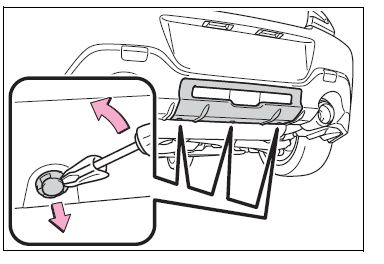
- To prevent damage to the vehicle, cover the tip of the screwdriver with a rag.
- Pull the cover to disengage each claw and remove it.
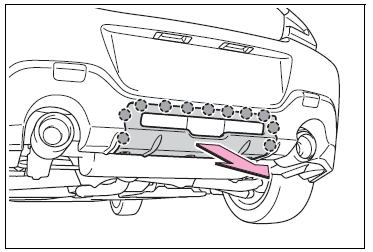
- Turn the bulb base counterclockwise.

- Remove the light bulb.
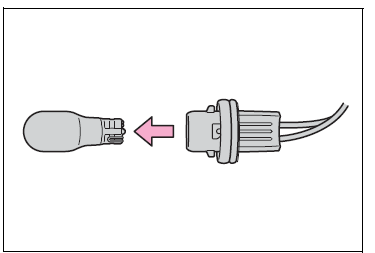
- Install a new light bulb then install the bulb base to the light unit by inserting it and turning the bulb base clockwise.

- Install the cover.
- Align the cover with the claws on the vehicle and push the cover toward the front of the vehicle to engage each claw and install it.
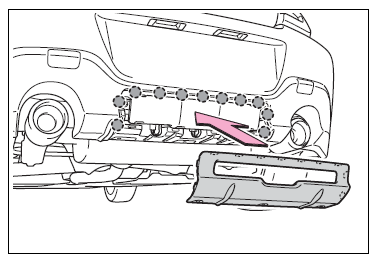
- Align the cover with the claws on the vehicle and push the cover toward the front of the vehicle to engage each claw and install it.
- Install the clips.

WARNING
- Replacing light bulbs
- Turn off the lights. Do not attempt to replace the bulb immediately after turning off the lights. The bulbs become very hot and may cause burns.
Do not touch the glass portion of the light bulb with bare hands. When it is unavoidable to hold the glass portion, use and hold with a clean dry cloth to avoid getting moisture and oils on the bulb. Also, if the bulb is scratched or dropped, it may blow out or crack. - Fully install light bulbs and any parts used to secure them. Failure to do so may result in heat damage, fire, or water entering the light unit. This may damage the lights or cause condensation to build up on the lens.
- When changing the backup lights
- Stop the engine and wait until the exhaust pipes and surrounding parts have cooled down sufficiently. The lights are located near the exhaust pipe and touching a hot exhaust pipe and surrounding parts can cause burns.
- To prevent damage or fire
- Make sure bulbs are fully seated and locked.
- Check the wattage of the bulb before installing to prevent heat damage.
FAQ’s
For optimal performance, Toyota recommends an oil change every 10,000 miles or 12 months, whichever comes first. Utilize high-quality synthetic oil to ensure engine longevity.
To maintain the integrity of your Toyota 86, it’s advisable to use genuine Toyota parts for repairs and maintenance. These parts are specifically designed for your vehicle, ensuring compatibility and performance.
Rotate your tires every 5,000 to 7,500 miles to promote even tread wear. Regular tire rotation extends the lifespan of your tires and contributes to a smoother driving experience.
Toyota recommends replacing brake fluid every 30,000 miles or 36 months, whichever occurs first. This helps maintain braking efficiency and ensures the longevity of brake components.
While some aftermarket brake pads may be suitable, it’s recommended to use genuine Toyota brake pads. They are engineered to meet the specific requirements of your vehicle.
Use Toyota Super Long Life Coolant or equivalent to ensure proper engine cooling and prevent corrosion. Check the coolant level regularly and top up as needed.
Replace spark plugs every 60,000 miles or as indicated in your owner’s manual. Fresh spark plugs contribute to efficient combustion and maintain engine performance.
Regularly inspect the brake system, including brake pads, rotors, and brake fluid, during routine maintenance. Address any issues promptly to ensure the braking system’s optimal performance and safety.
While it’s not mandatory, using nitrogen in tires can provide more stable tire pressure. If using nitrogen, ensure it meets purity standards and regularly check and adjust tire pressure as needed.
The 2022 Toyota 86 is equipped with a timing chain, eliminating the need for regular replacement. Inspect it during routine maintenance to ensure it is in good condition.
Useful Links:
View Full PDF: Toyota 86 2022 User Guide | Auto User Guide
Download Manual: https://www.toyota.com/owners/resources/warranty-owners-manuals
2023 Toyota GR86 Specs, Price, Features and Mileage (Brochure)


